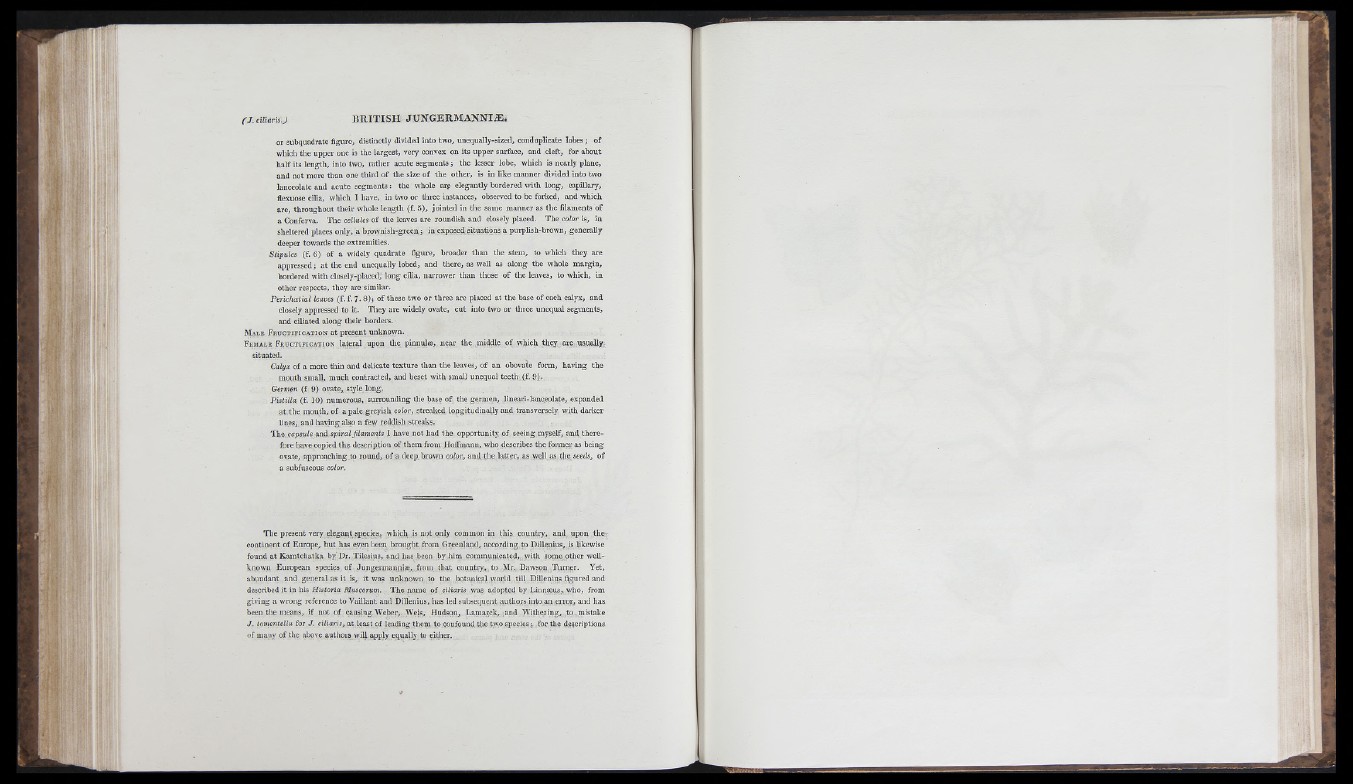
o r sub(juadrate figure, distinctly divided into two, unequally-sized, conduplicate lobes ; o f
which th e uppe r one is the la rg e st, very convex on its up p e r surface, and cleft, for a b o u t
lia lf its length, into two, ra th e r a cu te segments 3 th e lesser lobe, which is nearly plane,
and n ot more th an one th ird o f th e size o f tlie o th e r, is in like manne r divided in to two
lanceolate and a cu te segments : th e whole are elegantly bordered with long, capillaiy,
flexuose cilia, which I have, in two or three instances, observed to be forked, and which
a re , thro u g h o u t th e ir whole len g th (f. 5 ), jo in ted in tlie same manne r as th e filaments of
a Conferva. T h e cellules o f th e leaves are roundish and closely placed. T h e color is, in
sheltered places only, a brownish-gre en ; in exposed situations a purplish-brown, generally
deeper towards th e extremities.
Stipules (f. 6) o f a widely quadra te figure, broader th a n th e stem, to which th ey are
appressed 3 a t th e end unequally lobed, and th e re , as well as a long the whole m a rg in ,
bordered w ith closely-placed, lo n g cilia, narrower th a n tliose o f th e leaves, to which, in
o th e r respects, they are similar.
Perichætial leaves (f. f. 7 . S); o f the se two o r th re e a re placed a t th e base o f each calyx, and
closely appressed to it. They are widely ovate, c u t into two o r th re e unequa l segments,
and ciliated a long th e ir bordera.
M a l e F r u c t if ic a t io n a t p r e s e n t u n k n o w n .
F em a l e F r u c t if ic a t io n la te ra l upon th e pinnulæ, n e a r the middle o f which th ey are usually;
situated.
Calyx o f a more thin and delicate tex tu re than th e leaves, o f an obovate form, h aving th e
m outh small, m u ch contracted, and beset with small unequal te e th (f. 9).
Germen ( f 9) ovate, style long.
P is tilla (f. 10) numerous, surrounding the base o f the germen, lineari-lanceolate, expanded
a t th e m outh, o f a pa le greyish color, streaked longitudinally and transversely with darker
lines, and h aving also a few reddish streaks.
T h e capsule and spiral filaments I have not had th e opportunity o f seeing myself, and th e re fore
h ave copied th e description o f th em from Hoffmann, who describes th e former as being
ovate, approaching to rou n d , o f a deep brown coloi; and th e la tte r, as well as the seeds, of
a subfuscous color.
T h e present very e legant species, which is n ot only cominon in th is country, and u pon th e
c ontinent o f E urope, b u t has even been b ro u g h t from Greenland, according to Dillenius, is likewise
found a t K am tch a tk a by Dr. Tilesius, and has been by h im communicated, with some o th e r well-
known European species o f Ju n g e rm an n iæ , from th a t country, to Mr., Dawson T urne r. Yet,
abundant and general as it is, i t was u nknown to th e botanical world till Dillenius figured and
described it in his Hisloria Muscorum. T h e name o f ciliaris was adopted by Linnæus, who, from
giving .1 wrong reference to V a illant and Dillenius, has led subsequent authors into a n e rror, and has
been the means, if not o f causing Weber, Wejs, Hudson, Lamarck, and W ithe ring, to. mistake
J . tomentella for J . ciliaris, a t least o f leading th em to confound tfie two species j for the descriptions
o f m any o f th e above authors will apply equally to either.